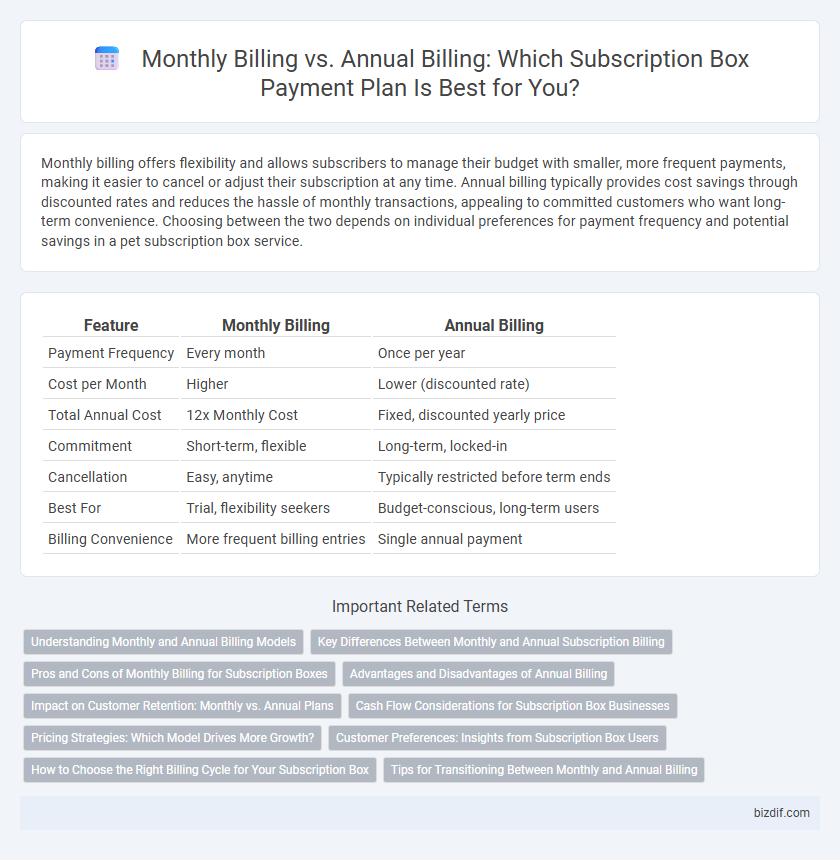Monthly billing offers flexibility and allows subscribers to manage their budget with smaller, more frequent payments, making it easier to cancel or adjust their subscription at any time. Annual billing typically provides cost savings through discounted rates and reduces the hassle of monthly transactions, appealing to committed customers who want long-term convenience. Choosing between the two depends on individual preferences for payment frequency and potential savings in a pet subscription box service.
Table of Comparison
| Feature | Monthly Billing | Annual Billing |
|---|---|---|
| Payment Frequency | Every month | Once per year |
| Cost per Month | Higher | Lower (discounted rate) |
| Total Annual Cost | 12x Monthly Cost | Fixed, discounted yearly price |
| Commitment | Short-term, flexible | Long-term, locked-in |
| Cancellation | Easy, anytime | Typically restricted before term ends |
| Best For | Trial, flexibility seekers | Budget-conscious, long-term users |
| Billing Convenience | More frequent billing entries | Single annual payment |
Understanding Monthly and Annual Billing Models
Monthly billing offers flexibility and lower upfront costs, making it ideal for customers seeking short-term commitment with predictable, recurring payments. Annual billing typically provides cost savings through discounted rates and reduces transaction frequency, appealing to customers willing to commit long-term. Understanding these models helps businesses optimize revenue streams and tailor subscription strategies to different customer preferences.
Key Differences Between Monthly and Annual Subscription Billing
Monthly subscription billing offers flexibility with smaller, frequent payments and easier cancellation, while annual billing provides cost savings through discounted rates and reduces transaction frequency. Customers selecting annual plans often benefit from bonus features or exclusive content not typically available in monthly options. Businesses leveraging annual billing can improve cash flow predictability and customer retention rates by securing longer-term commitments.
Pros and Cons of Monthly Billing for Subscription Boxes
Monthly billing for subscription boxes offers flexibility, allowing customers to easily pause or cancel their subscriptions without a long-term commitment, which can increase customer satisfaction and reduce churn. However, it often results in higher transaction fees for providers and less predictable revenue streams, complicating financial planning and inventory management. This billing cycle can attract price-sensitive consumers but may require more frequent marketing efforts to maintain subscriber engagement.
Advantages and Disadvantages of Annual Billing
Annual billing offers the advantage of cost savings by providing discounts compared to monthly payments, making it ideal for long-term subscribers seeking value. This billing method reduces transaction frequency, enhancing convenience and minimizing the risk of service interruptions due to payment issues. However, the upfront cost is higher, which can be a disadvantage for budget-conscious customers, and it may reduce flexibility if the subscriber wants to cancel or modify the plan before the year ends.
Impact on Customer Retention: Monthly vs. Annual Plans
Monthly billing plans often enhance customer retention by offering greater flexibility and lower upfront costs, which reduce the commitment barrier. Annual billing, while requiring a larger initial payment, tends to improve long-term retention by securing customer loyalty through extended renewal cycles. Subscription services balancing both options can cater to different customer preferences, optimizing retention rates across diverse user segments.
Cash Flow Considerations for Subscription Box Businesses
Monthly billing ensures a steady inflow of revenue that supports ongoing operational expenses and inventory replenishment for subscription box businesses. Annual billing offers a substantial upfront cash boost, improving short-term liquidity and enabling bulk purchasing or marketing investments. Balancing both models helps optimize cash flow management by combining consistent monthly income with large periodic payments for enhanced financial stability.
Pricing Strategies: Which Model Drives More Growth?
Monthly billing offers flexibility and lower upfront cost, increasing customer acquisition by reducing commitment barriers, which can lead to higher churn rates. Annual billing provides upfront revenue and better cash flow management, often appealing to loyal customers through discounted pricing, thus enhancing customer lifetime value. Subscription box companies driving growth typically balance both models, using annual plans to secure committed users and monthly plans to attract trial subscribers.
Customer Preferences: Insights from Subscription Box Users
Subscription box users often prefer monthly billing for its flexibility and lower immediate cost, allowing them to easily pause or cancel their subscription without a long-term commitment. Annual billing appeals to customers seeking savings, as many subscription services offer discounts up to 20-30% compared to monthly payments. Data from subscription box platforms reveal that 60% of users choose monthly billing for trial or short-term use, while 40% opt for annual plans to maximize value and convenience.
How to Choose the Right Billing Cycle for Your Subscription Box
Choosing the right billing cycle for your subscription box depends on customer preferences, cash flow management, and retention goals. Monthly billing offers flexibility and lower upfront costs, making it attractive for new subscribers while supporting consistent revenue streams. Annual billing typically increases customer commitment and reduces churn, often providing better lifetime value through discounted pricing incentives.
Tips for Transitioning Between Monthly and Annual Billing
Transitioning between monthly and annual billing requires clear communication about the benefits, such as cost savings and convenience, to encourage customer adoption. Offering prorated adjustments or credits when switching billing cycles helps maintain customer trust and prevents billing confusion. Implementing automated notifications before billing changes ensures transparency and reduces churn during the transition process.
Monthly billing vs Annual billing Infographic

 bizdif.com
bizdif.com